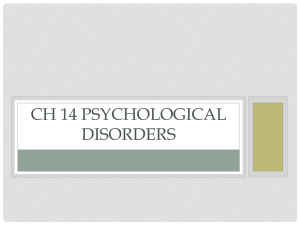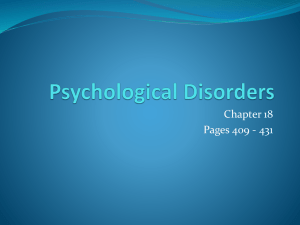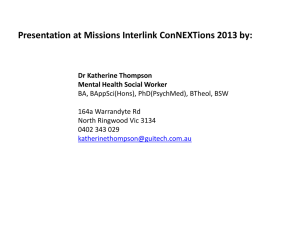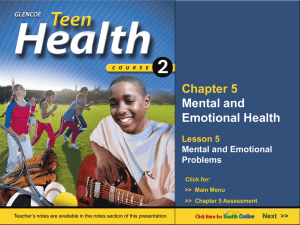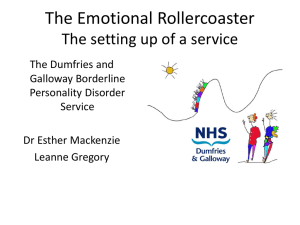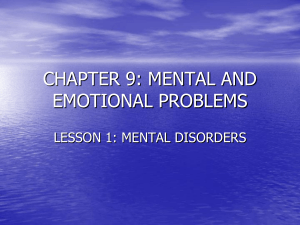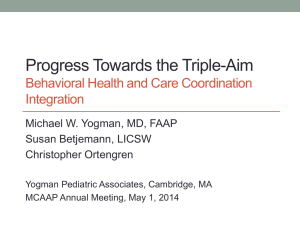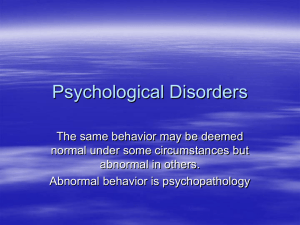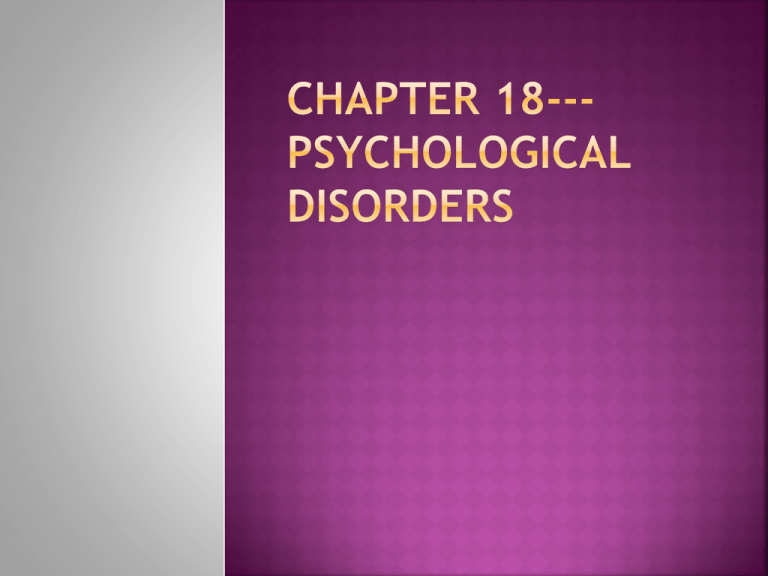
Behaviors
patterns or mental process
that cause serious personal suffering
or interfere with a person’s ability
to cope with everyday life.
1/3 of all adults have experienced
some type of psychological disorder.
What
is average for most
people?
Laughing/ too much at
nothing.
The
behavior of the majority is not
always wise or healthy
Some Atypical behaviors are
eccentric (artistic geniuses) rather
than indicative of a disorder
People with psych disorders usually
do not differ much from “normal”
people
Typically
what is most common
not a good guide
impairs
an individual’s ability to
function in everyday life.
hazardous to oneself or others
alcohol and drug use
anxiety
and depression
feelings of hopelessness, extreme
sadness, worthlessness,
Guilt, thought of suicide
severe emotional discomfort
violates
society’s accepted
norms
cultural differences a
problem
Change
with each edition of the DSM or
diagnostic and statistical manual of
mental disorders
The 3rd DSM edition in 1980 psychological
disorders have been categorized on the
basis of observable signs and symptoms
rather than presumed causes.
1.
2.
3.
Identify three problems with defining
normal behaviors as the behavior displayed
by the majority of people.
How have the criteria for the
classisification of psychological disorders
been arranged since 1980’s?
Give an example of a feeling or a behavior
that would be considered normal in one
circumstance but a sign of psychological
disorder in a different circumstance.
Anxiety Disorders
A
state of dread or uneasiness in
response to a vague/ imagined
danger
by
Persistent,
excessive,
irrational fear,
nervousness,
concern for lost of control,
inability to relax
trembling,
sweating,
rapid heart rate,
shortness of breath,
increase blood pressure,
flushed face,
feeling of faintness/ light head
Persistent,
excessive, irrational fear,
of a object or situation
Most common Types
zoophobia—fear of animals
claustrophobia—enclosed spaces
acrophobia---heights
arachnophobia---spiders
Panic
Disorder and Agoraphobia (50-80% of
phobic individuals)
Panic attack (recurring and unexpected)
a short period of intense fear (1 min – few
hours)
shortness of breath, dizziness, rapid hart
rate, sweating, choking, nausea, trembling,
shaking,
going to die for no apparent reason
fear of being in
places/ situations in
which Impossible to
escape
have panic attack
by avoiding
behaviors
Agoraphobia
(common among
adults)
excessive or unrealistic
worry about life
circumstances that lasts
for at least 6 months
common anxiety
disorder
typically focus on
finances, work,
interpersonal problems,
accidents or illness
Generalized
anxiety disorder
Obsessions -unwanted thoughts
ideas or mental
images.
Compulsions---repetitive ritual
behaviors
cleaner, checkers,
washers, Hoarders,
repeaters, orderers.
ObsessiveCompulsive
disorder (OCD)
flash
back, nightmares, numbness of
feelings, avoidance increased tension
causes- rape, severe child abuse, assault,
serve accident, airplane crash, natural
disasters, war experiences
Psychoanalytic view
•Anxiety is the result of forbidden
childhood urges that have been
repressed.
•When surfaced may become
obsessions and compulsive behaviors
Learning view
Phobias
are
conditioned or
learned in
childhood
May occur from
traumatic events
Cognitive
People
make
themselves feel
anxious by
responding
negatively to most
situations
Feel helpless to
control what
happens to them
Biological
views
Heredity
plays a role in most
psychological disorders
Interaction
factors-
both bio and psych together
1.
2.
3.
How does anxiety differ from fear?
Describe the relationship between
panic disorder and agoraphobia.
Explain why studies of twins are
important for determining whether
a disorder has a biological basis.
DISSOCIATIVE DISORDERS
REFERS
TO THE SEPARATION OF CERTAIN
PERSONILITY COMPPONENTS OR MENTAL
PROCESSES FORM CONSCIOUS THOUGHT.
MAY LOSE THEIR MEMORY OF A PARTICULAR
EVENT OR FORGET THEIR IDENTITY
OCCURS WHEN FACED WITH URGES OR
EXPERIENCES THAT VERY STRESSFUL
Characterized
by sudden lost of memory
following a stressful or traumatic event
Typically can’t remember any events that
occurred for a certain period of time
surrounding the traumatic event
May forget all prior experiences, personal
information, own name, family and friends
May last a few hours or years
No biologically explanation.
Characterized
by forgetting personal
information and past events
Taking on a new identity relocating from
home and new career
Usually follows a traumatic event
When fugue ends will not remember anything
during the fugue state
Formerly
called multiple personality disorder
Existence of 2 or more personalities
Personalities may or may not be aware of
each other
Personality: different (age, sex, health)
Typically have suffered severe physical,
sexual, and/or psychological abuse.
Feeling
of detachment from one’s mental
processes or body.
Feeling outside of your body/ observing
yourself
Common with other disorders
Stressful event
Dissociate
in order to prepress unacceptable
urges
Dissociative amnesia or fugue – forgets the
disturbing urges
Dissociative identity –develops- new
personalities to take responsibility
Depersonalization-goes outside of self away from
the turmoil within
Have
learned not to think about disturbing
events in order to avoid shame, guilt, and
pain
Dissociate themselves from stressful event
Reinforced by reduces anxiety when trauma
is forgotten
No
complete
explanation as of
yet
At
present there is
no convincing
evidence that
either biological or
genetic factors
play a role
1.Describe the four dissociative disorders.
2. In some cultures people are encouraged to
go into trance like states. Should this type of
dissociation be considered a sign of a
psychological disorder? Why or why not?
Somatoform Disorders
Expression
of psychological distress through
physical symptoms
Psychological problem along with physical
(paralysis)
The
conscious attempt to FAKE an illness in
order to avoid work, school, or other
responsibilities
People with somatoform disorders do not
fake their illness.
Honestly feel pain and paralysis
2 most common
Conversion disorder and
Hypochondria
Experience
change in or loss of physical
functioning in a major part of the body
No known medical explanation
Patient show little or no concern about their
symptoms.
Person’s
unrealistic preoccupation with
thoughts of illness or disease.
Maintains their erroneous belief despite
medical doctor
Psychological view
Primarily psychological
Repressing emotions associated with
forbidden urges/ expressed in physical
symptoms
Compromise unconscious need to express
feelings and fear of expressing them
Indications
that biological and genetic
factors involved.
1.
2.
3.
Define malingering. How does somatization
differ from malingering?
How do conversion disorder and
hypochondriasis differ?
How do you think learning theorists might
explain somatoform disorders? Do you agree
with this type of explanation? Why or Why
not?
Everyone
experience life's ups/downs
Some people experience mood changes that
seem inappropriate for or inconsistent with
the situation to which they are responding.
Life is good= sadness
Elated for no apparent reason
Abnormal moods like these, you may have a
mood disorder.
Depression
Feeling of
helplessness,
hopelessness,
worthlessness,
guilt, and great
sadness
Bipolar
disorder
Cycles of mood
changes
Depression----wild
elation
7 types of mood disorders
divided into
Depressive
and
bipolar disorders
Must
experience at least 5 of the following 9
symptoms for 2 wks/every day
Depressed mood for most of the day
Loss of interest pleasure in all things
Weight loss/ gain
Sleep more / less
Change in physical and emotional reactions
Fatigue/ loss of energy
Feeling worthless/ guilty
Inability to concentrate/ make decisions
Recurrent thoughts of death or suicide
Consumed
by feelings of worthlessness of
guilt
Calls for immediate treatment
15% or more eventually commit suicide.
Dramatic
ups and downs in mood
Period of mania or extreme excitement
Hyperactivity and chaotic behavior
change to Depression very quickly no
apparent reason
Traits
Inflated self-esteem
Inability to sit still
Pressure to keep talking and switching from topic
to topic
Racing thoughts
Difficulty concentrating
Highly excited
Act silly
Argumentative
Delusions about their
superior abilities
Others jealous of
them
Hallucination hearing
imaginary voices
Seeing things that are
not there
Impulsive behaviors
Quitting their jobs to
pursue wild dreams
Spending sprees
Foolish business
investments
Psychological
Internalizes anger- directs to themselves
Biological
View
Learned helplessness
Cognitive
view
Has a genetic basis( chemical imbalance)
25 % have family members who have moods
disorders
Learning
View
View
Habitual style of explaining life events based on
prior experiences
1.
2.
3.
What is the difference between depression
and bipolar disorder?
List five symptoms of major depression.
Describe and explain self-esteem, selfefficacy and expectancy from the
perspective of attribution theory.
Considered
the most serious
Typically Appears in young adulthood
May occur suddenly
Characterized by
- loss of contact with reality
Linked
to geneitcs
No cure
There is effective treatment
Hallucinations
Delusions
Thought
disorders
Auditory (voices)
delusions of grandeur (superior to others)
Persecution (paranoid)
Speech( disorganized confused)
Social withdraw
Loss of social skills
Loss of normal emotional responsiveness
Paranoid
Delusion of auditory hallucinations/ single theme
Grandeur-Jealousy- persecution-CIA after them
Disorganized
Incoherent in their thought/ speech/delusions/
hallucinations/emotionless/ inappropriate
emotions
Catatonic
Disturbance of movement/ slow/ stupor
switching to agitation/ holds body positions
Psychological
Overwhelming of the Ego by urges from the ID
Conflict fantasies confused with reality
Biological
View
View
A brains disorder/ frontal lobe
Bio risks- heredity complications during
pregnancy and birth
Multi-factorial
model of schizophrenia
Biological and psychological factors interact
Genetics create a vulnerability + trauma could =
schizophrenia
Once developed family environment can
negatively affect the disorder
Environmental factors alone does not lead to
schizophrenia.
1.
2.
3.
List four symptoms of schizophrenia.
How does paranoid schizophrenia differ
from disorganized schizophrenia?
Explain why a multi-factorial model of
schizophrenia may help in explaining the
disorder?
Patterns
of inflexible traits that disrupt
social life and work/ distress the person
Late in adolescence/ affect thought process,
emotions and behavior
Are enduring traits that are major
components of the individual’s personality
1-10% of the population (Antisocial
personality disorder)
Paranoid
Distrustful-suspicious of others
Difficult- argumentative, cold, aloof, view of
reality is distorted (isolated life)
Schizoid
personality disorder
personality disorder
No interest in relationship with people
Lack normal emotional responsiveness
No relationships-loners, few friends
Do not have delusion or hallucinations
Antisocial
Persistent behavior pattern of disregard/
violation of the right of other people
Do not feel guilt or remorse
Childhood---Hurt people and animals-steal
Adulthood—recklessness, no job, breaks the law
Avoidant
personality disorder
personality disorder
Want relationships/ fear and disapproval stops
them
Shy, withdrawn,
Always have social problems/ phobias
All encompassing condition
Psychological
view
Lack of guilt/ failure of developing a
conscious or super ego
Harsh punishment/ environment =lack
of sense of guilt
experiences influence learning how to
relate to people
No role models/ aggressive role models
Genetic\
runs in families
Frontal part of the brain/emotions
Fewer neurons than other people
Less responsive
Less likely to show guilt for their
misdeeds
Less likely to fear punishment
1.What is the major difference between
personality disorders and other psychological
disorders they may resemble?
2. Describe three behaviors of an individual
with avoidant personality disorder.
3. Why do you think people with antisocial
personality disorder are often more difficult
to treat than people with other ypes of
personality disorders?
PAGE 432 Thinking critically (1-5)
PAGE 433 Interpreting graphs (1+2)
Analyzing primary sources (3+4)



